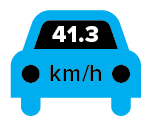
Greater Brisbane key corridors performance July-December 2015
Greater Brisbane road network
This report provides information on the traffic volume and average speed for the Greater Brisbane key transport corridors over the July to December 2015 period. These corridors include Brisbane City Council (Council) and Department of Transport and Main Roads (TMR) managed roads. Network summaries are presented in vehicle kilometres travelled (VKT) and average network speeds. The report includes information on initiatives being undertaken by both organisations to manage congestion on the road network.
Report findings
There are 37 key corridors, covering 327.3 kilometres, in the Greater Brisbane area. Network vehicle kilometres travelled increased by 0.2% from 2014 to 2015 for the July to December 2015 period.
AM peak average network speed on the 37 corridors is 41.3 km/h. PM peak average network speed is 41.4 km/h.
Highlights
Network vehicle kilometres travelled increased by 0.2% from the same period last year.
| Peak average network speed details | Speed |
|---|---|
AM peak average network speed is 41.3 km/h |  |
PM peak average network speed is 41.4 km/h | 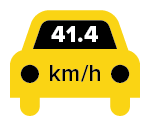 |
- Bruce Highway is the busiest corridor with an average daily volume of 162,121 vehicles per day • Logan Road (1) is the least busy at 21,179 vehicles per day
- In the AM peak, November saw the lowest average speed at 37.4 km/h while September had the highest average speed at 44.6 km/h
- In the PM peak, November had the lowest average speed at 37.6 km/h and August had the highest average speed at 44.2 km/h
- In the AM peak, Centenary Highway (2) is the fastest at an average speed of 72.6 km/h; slowest is Stanley Street at 16.7 km/h
- In the PM peak, Bruce Highway is the fastest at 90 km/h and slowest is Gympie Road at 20.7 km/h
- Between 2014 and 2015, AM peak average speed on Council’s 18 key corridors increased by 0.9 km/h (3%) from 29.7 km/h to 30.6 km/h. PM peak average speed also improved by 1.9 km/h (5.6%) from 34.4 km/h to 36.3 km/h.
Compiled by Council, with data and analysis jointly undertaken by Council and TMR. Incident data provided by the Brisbane Metropolitan Transport Management Centre (BMTMC).

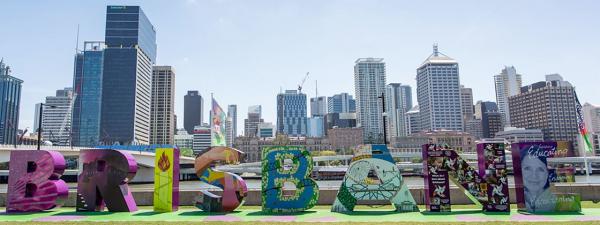
Greater Brisbane key corridors
Network vehicle kilometres travelled summary
Average vehicle kilometres travelled of 37 key corridors by month
Traffic volume and vehicle kilometres travelled
All traffic volume data includes weekdays only and excludes public holidays. Traffic volumes on TMR corridors were taken at the road segment with the highest volume. Council corridor traffic volumes were taken in the middle segment of the corridors.
The average daily traffic volume for the month is the number of vehicles utilising the corridor per day, averaged over all weekdays of the month (excluding public holidays).
AM peak period for TMR corridors is from 6am to 9am as the TMR network is utilised earlier particularly on the outer edges of the Greater Brisbane road network (for example, Bruce Highway, Pacific Motorway and so on). Council corridors’ AM peak period is from 7am to 9am. PM peak periods are the same for both TMR and Council corridors, 4pm to 7pm. The monthly AM and PM peak per hour traffic volumes are the average hourly volume for the month over the corresponding AM and PM peak periods, respectively.
Vehicle kilometres travelled (VKT) is a measure of traffic demand on the road network. It is the length of a section of road in kilometres multiplied by the average traffic volume on that section. The daily VKT is the product of the length of the road and average daily traffic (ADT). The monthly VKT is the daily VKT multiplied by the number of days in the analysis period.
The AM peak monthly VKT is the product of the length of the road, the average AM peak hourly traffic volume and number of days in the analysis period.
The PM peak monthly VKT is the product of the length of the road, the average PM peak hourly traffic volume and number of days in the analysis period.
The network VKT is the sum of all the corridors in the network.
Average network speed summary
Average speed of 37 key corridors
Average speed
Average speed in kilometres per hour is a measure of traffic efficiency on the road network. Average speed was calculated using travel times collected from TMR’s and Council’s extensive network of Bluetooth scanners within the Greater Brisbane road network. Average corridor speed includes delays at signalised intersections.
Average travel times were collected during the AM and PM peak periods to calculate the average speed of the corridor. Peak periods are similarly defined as in the VKT calculations.
AM peak travel time is taken as the inbound direction while the PM peak travel time is the outbound direction.
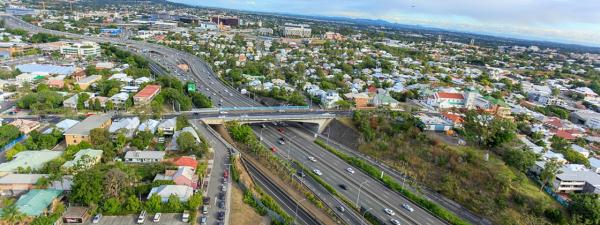
Kingsford Smith Drive: Case study
Historically, Kingsford Smith Drive (KSD) is one of the most significant routes in the city for Brisbane’s economic prosperity.
A major road corridor, KSD links the Brisbane CBD to Brisbane Airport, the Port of Brisbane and residential and economic growth areas including Northshore Hamilton and the Australia TradeCoast (ATC). The ATC is expected to be the second biggest job generator in South East Queensland, behind Brisbane’s CBD, in future years.
Traffic volume trend
The graph shows the average annual weekday traffic volume on KSD for the past eight years. KSD volume decreased significantly with the opening of the Airport Link (APL) tunnel in July 2012. Since then however, traffic volume has been increasing rapidly (one of the highest of the key corridors) and has surpassed pre-APL volumes.
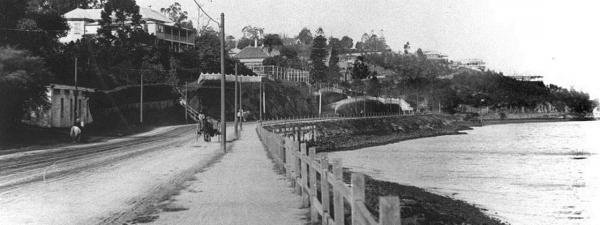
Average speed trend
From 2012, average corridor speeds have slowly decreased for the AM and PM peaks. With the continued economic growth of areas serviced by KSD, the average speed will likely continue to decrease.
By 2030, Northshore Hamilton alone will be home to around 15,000 people and will be a hub of employment for up to 10,000 people in commercial and retail businesses. Together with ATC, this is expected to generate approximately 30,000 extra vehicle trips per day.
The KSD upgrade is the next flagship project to be delivered by Council to transform Brisbane’s road network. The upgrade serves as a key part of Council’s balanced approach to tackling traffic congestion in Brisbane, which could cost businesses and residents up to $3 billion by 2020, if not addressed.
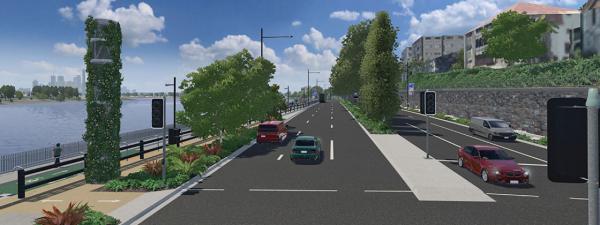
State government congestion initiatives
Ongoing TMR congestion management activities include:
- Managed Motorway operations e.g. South East Freeway ramp signalling, Ipswich Motorway Lane Use Management and Port of Brisbane Variable Speed Limit Operations
- Emergency Vehicle Priority (EVP) (with Council)
- Planning for Operations
- Signal network optimisation
- Brisbane Metropolitan Transport Management Centre including ongoing operations of Variable Message Signs and Closed-Circuit Television (with Council)
- Traffic Response Units (with Council)
- Bluetooth Travel Time Monitoring
- Mapping congestion hotspots.
Gateway Upgrade North
The upgrade between Nudgee and Bracken Ridge aims to benefit the community by improving motorist safety, reducing congestion and accommodating future traffic growth.
The $1.162 billion project is being jointly funded by the Australian and Queensland Governments and includes:
- upgrading 11.3 km of the Gateway Motorway from four to six lanes between Nudgee and Bracken Ridge
- reconfiguring the Nudgee interchange including a new Nudgee Road overpass and a relocated extended northbound on-ramp
- widening the Deagon Deviation between Depot Road and Bracken Ridge Road to provide two lanes in each direction
- modifications to the Bicentennial Road interchange including extended on and off-ramps
- construction of off-road cycle/pedestrian facilities
- installing Intelligent Transport Systems (ITS) including: variable message and speed signs, traffic monitoring cameras and ramp metering.
Key milestones:
- Mid-2015 – contract awarded for the major works
- Early 2016 – start of major works construction
- Late 2018 – completion and commissioning.
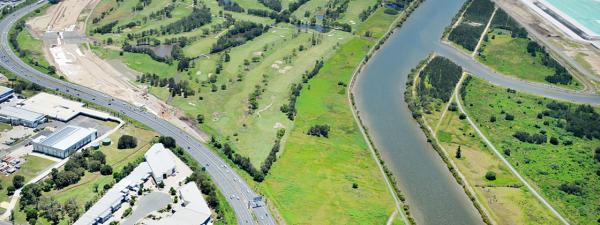
Bruce Highway Managed Motorways Project (BHMMP)
The Bruce Highway Managed Motorways Project involves a suite of smart technologies on the Bruce Highway southbound between Caboolture and the Gateway Motorway to optimise the performance of the highway and maximise its existing capacity during peak periods. Ramp signals and electronic communications technology have been installed at five onramps to the Bruce Highway southbound at Dohles Rocks Road, Anzac Avenue, Boundary Road, Deception Bay Road and Uhlmann Road. Installation of the ramp signals and electronic communications technology began in April 2014 and was completed in September 2015, with the system starting operation in September 2015.
The project aims to deliver the following benefits to motorists:
- managing traffic flow onto the highway at key congestion points to help keep traffic flowing on the highway and delay the onset of congestion
- providing safer merging conditions for motorists entering the highway
- reducing ‘stop-start’ travel for motorists and helping to improve travel time reliability
- optimising the performance of the Bruce Highway and maximising its existing capacity until future upgrades can take place
- allowing a proactive and responsive approach to managing network conditions and responding to congestion, incidents or bad weather.
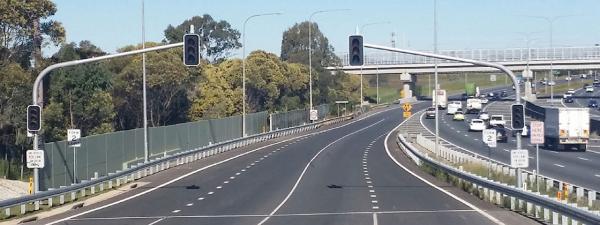
Gateway Upgrade South project
Stage 1 of the Gateway Upgrade South project to upgrade the motorway from four to six lanes from Mt Gravatt-Capalaba Road to Miles Platting Road was completed in July 2011. The Australian Government and Queensland Government committed $140 million of joint funding for design and construction of Stage 2 of the Gateway Upgrade South projects. Stage 2a which included upgrading the Mt Gravatt-Capalaba Road from Broadwater Road to Gardner Road was completed in mid-2015.
List of congestion management projects from Queensland Transport and Roads Investment Program
| Project location | Project description |
|---|---|
| Ipswich Motorway between Dinmore and Darra | Implementing ramp signalling |
| Centenary Highway between Indooroopilly and Toowong | Construction of additional lanes – from two to three lanes in each direction |
| South East Busway at Melbourne Street, South Brisbane | Widening of portal to accommodate potential future public transport demand |
| South East Freeway inbound ramps on Logan Road and Mains Road | Increase storage capacity to improve ramp signalling operations |
| Logan Road southbound off-ramp and associated section along Logan Road up to Padstow Road | Managing congestion with minor works, narrow additional lanes and localised widening |
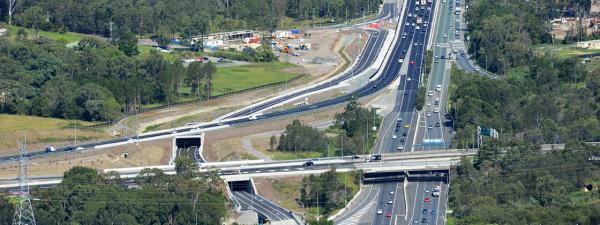
Council congestion initiatives
Council’s key congestion reduction initiatives include:
- Brisbane Metropolitan Transport Management Centre (with TMR)
- Emergency Vehicle Priority (EVP) (with TMR)
- Traffic Response Units (with TMR)
- Sydney Coordinated Adaptive Traffic System
- Variable Message Signs program
- Closed-Circuit Television program
- Pedestrian Countdown Timers
- Left Turn on Red
- Modular Infrastructure POD
- Bluetooth Travel Time Monitoring Network
- Arterial Road Program of Intersection Improvements.
Kingsford Smith Drive (KSD) upgrade
As a major gateway to the city for tourists, visitors and residents, KSD will be transformed into a vibrant urban corridor that maximises public access to the river and reinforces Brisbane’s identity as a New World City.
The KSD upgrade will create a subtropical arrival experience into Brisbane, providing shade and enhancing views of our river city.
Trees will be planted along the entire corridor, with centre median planting creating a memorable journey for all road users while maintaining views for local residents.
The KSD upgrade will involve widening the road from four to six lanes between Theodore Street at Eagle Farm and Cooksley Street at Hamilton. It will also include improvement works between Cooksley Street and Breakfast Creek Road at Albion.
In addition to providing increased road capacity to accommodate future traffic volumes, the upgrade will also deliver significantly improved pedestrian and cycle facilities, providing active transport options for both existing residents and the developing Northshore precinct.
Council selected Lendlease as the preferred contractor to design and construct the KSD upgrade.
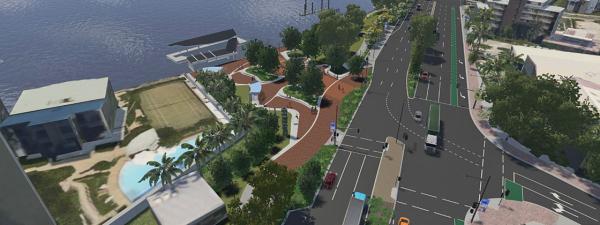
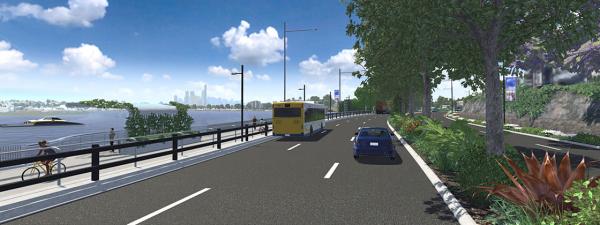
Inner City Bypass upgrade
Council is planning to widen the Inner City Bypass (ICB) between Legacy Way and the Royal National Agricultural (RNA) tunnel to increase capacity and allow for future growth along the key corridor.
The ICB 4 upgrade will see the ICB southbound widened from three to four lanes between the northern approach to the RNA tunnel and the Legacy Way portal, and the ICB northbound widened from three to four lanes between Legacy Way and the ICB Herston exit.
The upgrade will reduce traffic congestion and increase capacity for existing and future traffic demands. This section of the ICB currently carries more than 100,000 vehicles per day and is a major link in the road network with connections to Lutwyche Road, Airport Link Tunnel, Clem Jones Tunnel, Legacy Way Tunnel and the soon-to-be-upgraded KSD.
$80 million will be allocated over the next three years for the project and a contract tender process is planned to occur during the next year.
As part of the preliminary design, Council will be undertaking a technical investigation to determine if a new westbound on-ramp from Bowen Bridge Road/Inner Northern Busway is feasible. This is expected to be completed in early 2016.
Construction is tentatively scheduled to begin in late 2016 and be completed in 2018.
Wynnum Road corridor upgrade – stage 1
The Wynnum Road corridor is an important route in Brisbane’s road network, providing access between suburban and commercial catchments in the eastern suburbs of Brisbane, the CBD and beyond.
Council is planning to deliver the upgrade to the Wynnum Road corridor in stages. Stage 1 of the upgrade is from Latrobe Street to Canning Bridge and will see this section of Lytton Road widened from four to six lanes.
Roads and intersection upgrades
Council is building an improved road and transport network across Brisbane through a range of key projects including major road construction and intersection upgrades. To improve access to major transport networks, Council is also working to minimise traffic congestion and improve safety in local areas by constructing intersections, and undertaking corridor upgrades and minor road projects.
Upgrades under this program are part of Council’s $49 million commitment in 2015-16 for suburban road and intersection upgrade projects. This program is part of Council’s commitment to keep Brisbane moving, and is jointly funded by the Queensland Government under the Transport Infrastructure Development Scheme.
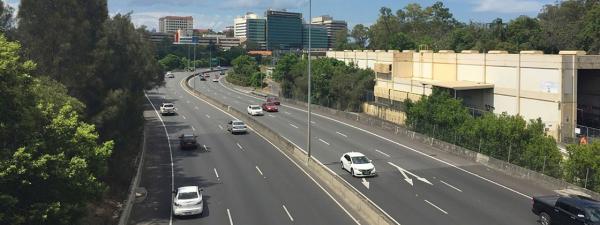
Our roads are one of our most critical assets, which is why Council continues to prioritise their maintenance. Council’s 2015-16 road resurfacing program will help make suburban streets smoother, safer and more enjoyable to use every day, representing a $100 million investment. Works will occur across every Council ward and will deliver an unprecedented number of resurfacing projects for Council within this period of time.
This $100 million investment for the 2015-16 financial year will build on Council’s commitment of $240 million of road resurfacing works over four years to ensure Brisbane’s transport network continues to deliver a high-quality experience for users.
Congestion reduction projects for July to December 2015
| Project location | Suburb | Project description |
|---|---|---|
| Toombul Road at St Vincents Road | Northgate | Parking restriction to provide more capacity |
| Given Terrace at Ranley Grove | Paddington | Formalise dual outbound lanes as clearway already exists |
| Old Cleveland Road at Montague Street | Greenslopes | Provision of a double right turn out of Montague Street by creating a second short right-turn lane |
| Vulture Street between Merivale Street and Cordelia Street | South Brisbane | Extended the existing short second lane on Vulture Street west between Cordelia Street and Merivale Street from 15 metres to 70 metres |
| Beenleigh Road at Saint Andrew Street | Kuraby | Extended the right-turn lane on Beenleigh Road into Saint Andrew Street by 20 metres |
| Warrigal Road at Bleasby Road | Eight Mile Plains | Marking ‘no stopping’ yellow line on Warrigal Road northbound after the shopping centre exit |
Factors affecting network performance
Significant incident data
Traffic volume and travel time are also affected by other factors including traffic incidents. These incidents, such as accidents, extreme weather and planned events, influence the amount of congestion experienced on the roads. Depending on the timing, location, severity and duration, an incident may have minimal effect on the road network or cause gridlock in large parts of the city. The data detailed in this report specifically analysed significant incidents that had the potential to have a major impact on the road network.
This incident data was collected and compiled from roads throughout the Brisbane metropolitan area by the Brisbane Metropolitan Transport Management Centre (BMTMC).
| Month | Number of incidents | Average duration¹ (HH:MM:SS) |
|---|---|---|
| July | 392 | 1:06:34 |
| August | 379 | 0:47:17 |
| September | 346 | 0:51:39 |
| October | 352 | 1:09:14 |
| November | 358 | 2:11:00 |
| December | 281 | 1:45:09 |
1 Incident duration is measured from the time BMTMC is notified about the incident until the time the incident is resolved.